H-Cat P-12 X10 Doppler-Free Line Stage and DF-100.2 X10 Stereo Amplifier
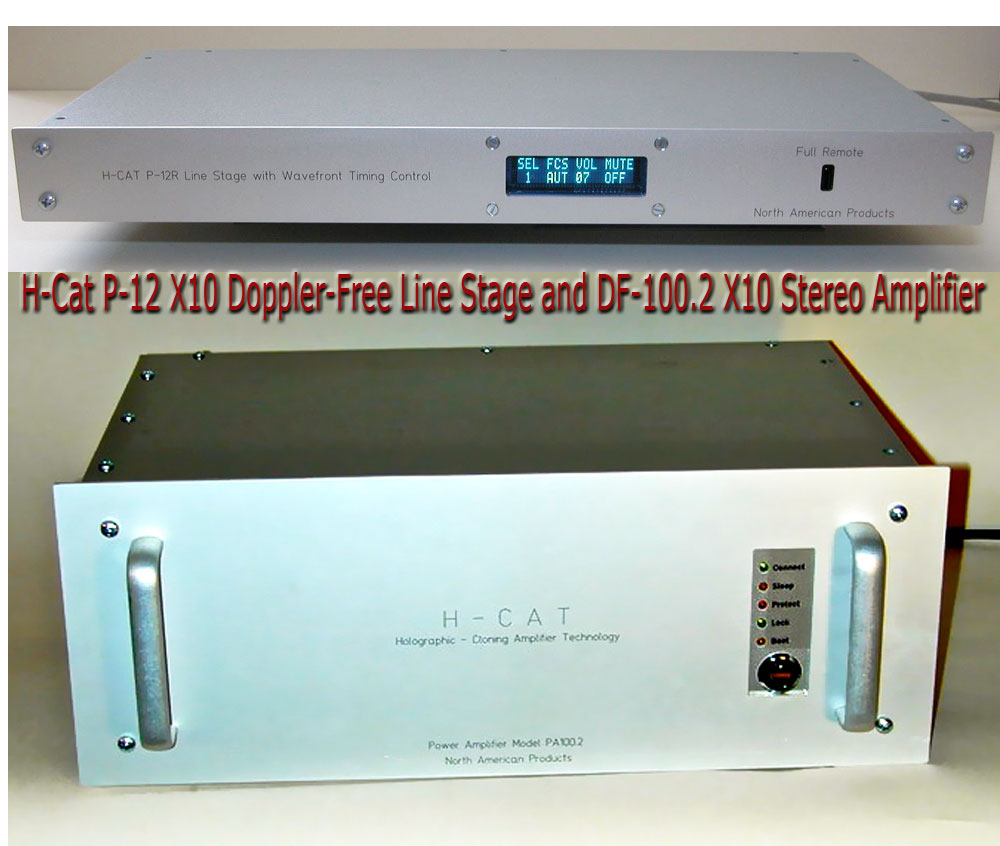
 Many years ago, I touted a new preamp by a man I first met long ago at a Chicago CES Show. I found it exceptional (as did The Absolute Sound that ultimately gave it a Golden Ear Award). I repeatedly had upgrades made, as the company’s technology improved. Several years ago the company seemed likely to cease. Nevertheless, I retained a preamp and amplifier that are in used in my second system. Then I learned that the company had arisen and had automatic wave timing corrections, as opposed to the earlier “wave timing control,” that one set to their satisfaction often on each recording and often with great benefit. If the automatic circuit worked, this would a great improvement, I thought.
Many years ago, I touted a new preamp by a man I first met long ago at a Chicago CES Show. I found it exceptional (as did The Absolute Sound that ultimately gave it a Golden Ear Award). I repeatedly had upgrades made, as the company’s technology improved. Several years ago the company seemed likely to cease. Nevertheless, I retained a preamp and amplifier that are in used in my second system. Then I learned that the company had arisen and had automatic wave timing corrections, as opposed to the earlier “wave timing control,” that one set to their satisfaction often on each recording and often with great benefit. If the automatic circuit worked, this would a great improvement, I thought.
A former dealer told me the X-10 was outstanding and quickly sold his demo unit. I asked for one for review and did get one even though production is just beginning with updating of old units. Actually, I also got the new amplifier upgrade also. This is a review of both components.

Physically, both units are very utilitarian aluminum cabinets and are light weight. The preamp has four unbalanced inputs and two unbalanced outputs. It is available both with remote controlable and not. It weighs only ten pounds.
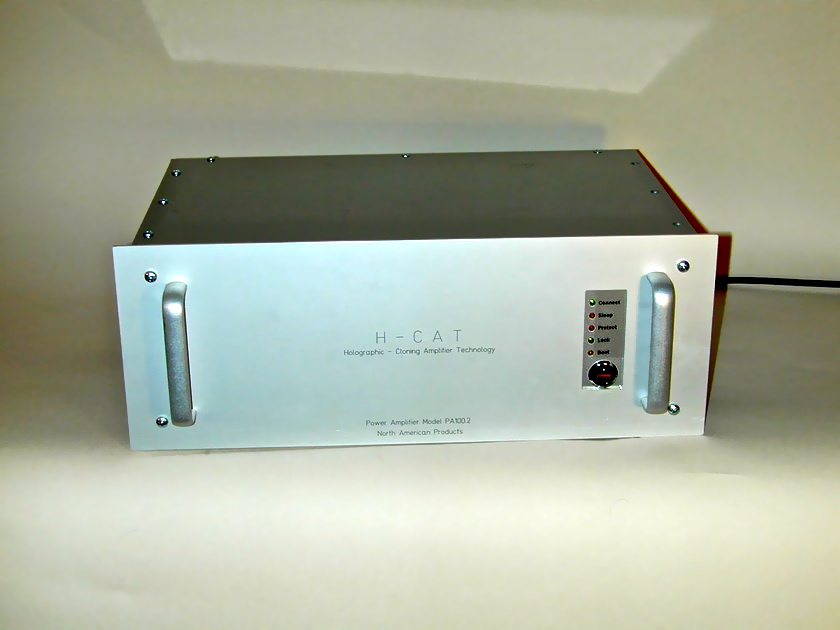
The amp has unbalanced inputs and two output binding posts sets on each side. It weighs only twenty-eight pounds. Nominally, its output in 100 watts into eight ohms, but with the stupendous bass with this circuit, I never heard any clipping.
There are several terms associated with the technology in this equipment. One is Doppler. This is a measure of signals speed toward or away from a source or in this case through the circuit. This is commonly conveyed by the sound of a train approaching and then changing pitch as it moves past you. Here it is the various frequencies in the signal that have their velocity assessed. The goal is absolutely no difference in time to get through the circuit at any frequency relative to the others. Even microscopic speed differences can result in phase differences. How this is accomplished is proprietary, and I know they have to make their own device to do this, but the results are no phase shifts. This is more discussed in a white paper shown on their webpage, H-Cat.com.
This lends itself to the second term, holographic imagining, which is the illusion of the performance being there before you. This is the origin of H-Cat (Holographically Cloning Amplifier Technology. Since in a live performance with the sound merely traveling through the air has no differences in the speed of different frequencies arriving at your ears, this circuit duplicates what you would have heard at the recording.
There used to be another term of relevance here, namely “star grounding.” This is having only the line stage grounded to the electrical system. All other components are grounded to the line stage through the interconnects. I did not do this in my present system, as I have the Tripoint Troy grounding system, which does it but with a special capability to not allow one component to affect another. In the past I did try this, and it was quite effective.
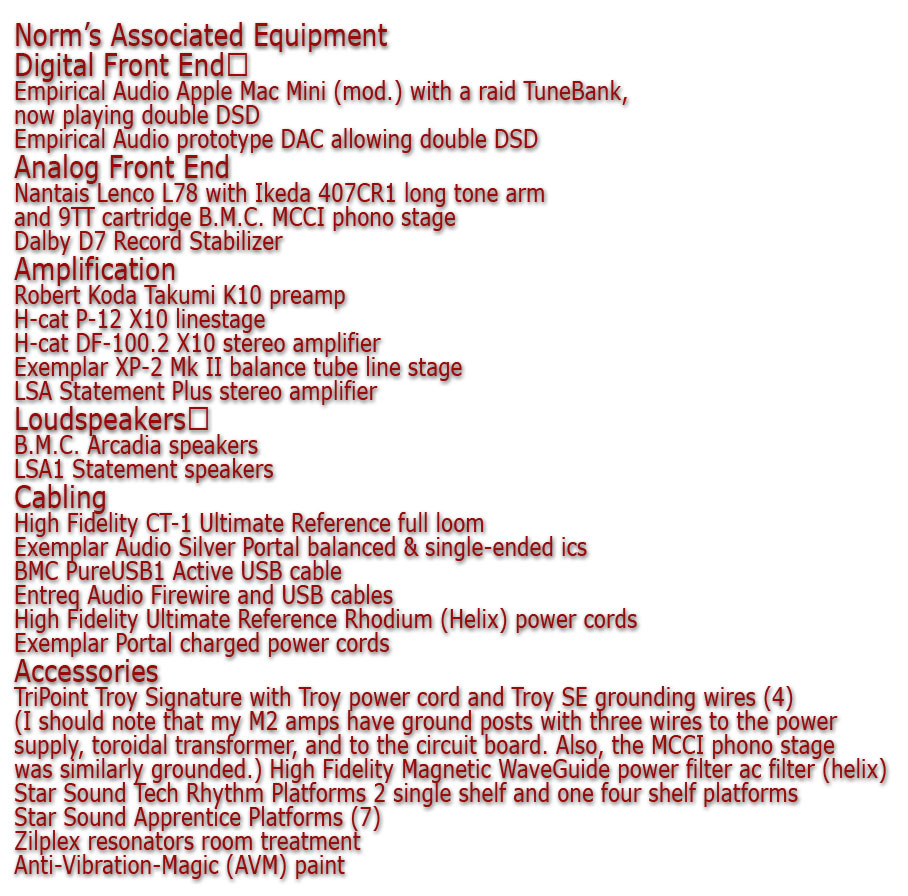 Setup
Setup
I only made one alteration of my system in this review. One of my reference B.M.C. amplifiers would hum with the H-Cat line stage. No other amplifier hummed with it and no other line stage hummed with the amp. I have established that it was the amp. This amp had an under value resistor that has now been replaced. As a result, this really is a review of both the H-Cat line stage and amplifier. This proved to be a very fortunate happening, as the H-Cat amp proved to be the star performer.
I should also note that this review was done with two entirely different systems. One was my primary system for which I am posting all components. The other was my inexpensive system in my New Mexico summer home where I have a 13 by 10 by 8 feet room with LSA1 Statement speakers, Exemplar eXception ics and speaker wires and their charged Portal pcs, Stillpoints dual Component stands with their pipes between them and with Ultra SSs under the components, and with an old Mana Reference rack with Stillpoints Ultra Minis under my EAL Mac Mini music server.
As the amp in particular took a good deal of time to break in, the review is based primarily on listening experiences in the small and inexpensive room at my New Mexico home.
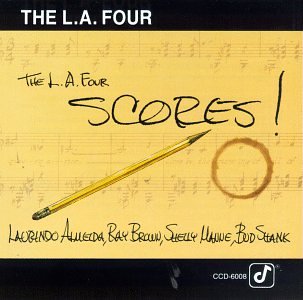
Listening Sessions
The H-Cat line stage and amp were absolutely just completed when shipped to me, so I expected some curing of the potting compound in the modules. Indeed, that was the case. Initially in Texas, I did leave them both on continuously for three days and listened each day. There was continuous improvement, but the fourth day rewarded me with a great improvement that made me think erroneously that the break-in was complete. The precision of the soundstage just snapped into play. On many recordings the entire speaker end of the room seemed to be the sound stage at the recording regardless of whether it was in a studio or in a hall; even the L.A. Four’s outdoor recording, The L. A.. Four Scores!, seemed real and, of course lacked ambience. The wind blowing, however, was obvious.
My old dependable, (Sinatra At The Sands, Vicy (94366 Japan) SHM) gave the most “you are there” impression yet. There is an audience and a big orchestra, plus Sinatra and Basie present. I particularly like the piece, One for 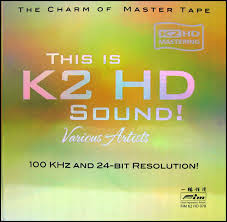 My Baby (and One More for the Road). The clear sense of being in the room and the precise locations of Sinatra, Basie, the band, and the audience as well, resulted in much realism. Ansermet’s conducting of Tchaikovsky’s Swan Lake Duo selection on the K2 sampler (This Is K2 HD Sound, UD! FIM (K2 HD 078)), again lends an openness and clarity to the music. But for the first time I heard depth in the orchestra as well as decay of the notes. I suspect that the absence of phase differences played a major role in achieving this sense. Finally, there is Paul Simon’s Songwriter Sony Legacy (B005KLNOLA). The first cut is The Sound of Silence done in Webster Hall live. He is alone with his guitar. This is the most real sounding cut of the album, including the several young men in the audience making asses of themselves. With the H-Cat X10 the sense of his looking out into the audience lent such realism that I wanted to yell at the guys to shut up!
My Baby (and One More for the Road). The clear sense of being in the room and the precise locations of Sinatra, Basie, the band, and the audience as well, resulted in much realism. Ansermet’s conducting of Tchaikovsky’s Swan Lake Duo selection on the K2 sampler (This Is K2 HD Sound, UD! FIM (K2 HD 078)), again lends an openness and clarity to the music. But for the first time I heard depth in the orchestra as well as decay of the notes. I suspect that the absence of phase differences played a major role in achieving this sense. Finally, there is Paul Simon’s Songwriter Sony Legacy (B005KLNOLA). The first cut is The Sound of Silence done in Webster Hall live. He is alone with his guitar. This is the most real sounding cut of the album, including the several young men in the audience making asses of themselves. With the H-Cat X10 the sense of his looking out into the audience lent such realism that I wanted to yell at the guys to shut up!
As I waited for evidence that breakin was completed, I frequently just listened to random albums off my music server, where I have over 500 albums. I rediscovered several albums that I had ignored for many years. The BMC mono blocks afford single ended, balanced, and current injected inputs and have twice the power, but they do not afford a sound stage, where you really have a sense that you could walk to the right of the singer and stand in front of the drummer.
Conclusion
While I am mindful that my High Fidelity Cables and power cords are contributing to the detail evident in the imaging as is the grounding provided by the Tripoint Troy and the new Thor SE grounding cables. The Star Sound Tech. Rhythm rack and platforms also stabilized the sound stage and greatly added dynamics. Only the Koda K10 rival the performance I’m hearing with the H-Cat X-10 line stage. Both line stages were used with the H-Cat amp. The Koda’s bass is more profound and looser as the room flooring shakes and it is smoother, but the H-Cat has more definition and detail that makes the sound stage more defined giving the sense of being there.. I have heard the evolution of the H-Cat P-12 line stage from shortly after it receive the Golden Ear Award from The Absolute Sound. I heard many improvements over time, but the X-10 version is major. This really is a breakthrough product even disregarding the price. Once you note the price, it is, I think, revolutionary. I would say that I am buying the review samples, but I am not. I already own an earlier H-Cat line stage and amplifier and the upgrade price is $2000 for each component.
I thought this would be the end of the review, but at one point the sound just soared. The image just jumped into focus with immense detail of every thing and performer. Often one could hear the presence of a performer as in the case of the marimba player in Pachelbel Canon in D (This Is K2 HD Sound, UD! FIM (K2 HD 078)). He has to move up and down the instrument, and you can sense his movement. This, of course, in not music, but it lends to realism.
What is music is evidenced by the amp’s capability to easily deal with crescendos. There is a total effortlessness to its sound as well as timberal accuracy to all instruments. The bass is both profound and defined. I certainly cannot claim to have heard all quality amps or sound systems including amps and line stages, but this certainly is the best I have ever heard and what I love is that it is affordable, and for me cheap, as I already owned both components and merely had to update them.


norm luttbeg
Specifications
Price:PH-Cat P-12R (X-10) line stage: $5995
Price: H-Cat DF-100.2 (X-10) stereo power amplifier: $10,995
North American Products
Address:
700A South White Horse Pike
Suite 197
Somerdale, NJ 08083
Email: info@h-cat.com
Website: www.h-cat.com
Stereo Times Masthead
Publisher/Founder
Clement Perry
Editor
Dave Thomas
Senior Editors
Frank Alles, Mike Girardi, Russell Lichter, Terry London, Moreno Mitchell, Paul Szabady, Bill Wells, Mike Wright, and Stephen Yan,
Current Contributors
David Abramson, Tim Barrall, Dave Allison, Ron Cook, Lewis Dardick, John Hoffman, Dan Secula, Don Shaulis, Greg Simmons, Eric Teh, Greg Voth, Richard Willie, Ed Van Winkle, Rob Dockery, Richard Doran, and Daveed Turek
Site Management Clement Perry
Ad Designer: Martin Perry





Be the first to comment on: H-Cat P-12 X10 Doppler-Free Line Stage and DF-100.2 X10 Stereo Amplifier